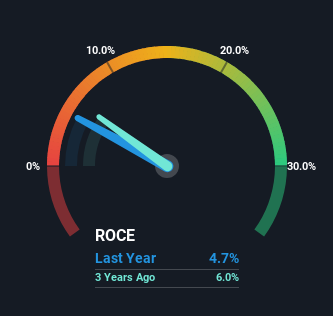Returns On Capital Signal Tricky Times Ahead For Shinkong Synthetic Fibers (TWSE:1409)
If we want to find a stock that could multiply over the long term, what are the underlying trends we should look for? Typically, we'll want to notice a trend of growing return on capital employed (ROCE) and alongside that, an expanding base of capital employed. This shows us that it's a compounding machine, able to continually reinvest its earnings back into the business and generate higher returns. In light of that, when we looked at Shinkong Synthetic Fibers (TWSE:1409) and its ROCE trend, we weren't exactly thrilled.
Return On Capital Employed (ROCE): What Is It?
For those who don't know, ROCE is a measure of a company's yearly pre-tax profit (its return), relative to the capital employed in the business. Analysts use this formula to calculate it for Shinkong Synthetic Fibers:
Return on Capital Employed = Earnings Before Interest and Tax (EBIT) ÷ (Total Assets - Current Liabilities)
0.047 = NT$3.2b ÷ (NT$188b - NT$119b) (Based on the trailing twelve months to September 2023).
Therefore, Shinkong Synthetic Fibers has an ROCE of 4.7%. On its own that's a low return on capital but it's in line with the industry's average returns of 5.2%.
See our latest analysis for Shinkong Synthetic Fibers

Historical performance is a great place to start when researching a stock so above you can see the gauge for Shinkong Synthetic Fibers' ROCE against it's prior returns. If you'd like to look at how Shinkong Synthetic Fibers has performed in the past in other metrics, you can view this free graph of Shinkong Synthetic Fibers' past earnings, revenue and cash flow.
What The Trend Of ROCE Can Tell Us
When we looked at the ROCE trend at Shinkong Synthetic Fibers, we didn't gain much confidence. To be more specific, ROCE has fallen from 9.8% over the last five years. Given the business is employing more capital while revenue has slipped, this is a bit concerning. If this were to continue, you might be looking at a company that is trying to reinvest for growth but is actually losing market share since sales haven't increased.
On a side note, Shinkong Synthetic Fibers' current liabilities are still rather high at 63% of total assets. This effectively means that suppliers (or short-term creditors) are funding a large portion of the business, so just be aware that this can introduce some elements of risk. Ideally we'd like to see this reduce as that would mean fewer obligations bearing risks.
Our Take On Shinkong Synthetic Fibers' ROCE
In summary, we're somewhat concerned by Shinkong Synthetic Fibers' diminishing returns on increasing amounts of capital. But investors must be expecting an improvement of sorts because over the last five yearsthe stock has delivered a respectable 65% return. In any case, the current underlying trends don't bode well for long term performance so unless they reverse, we'd start looking elsewhere.
One more thing: We've identified 3 warning signs with Shinkong Synthetic Fibers (at least 2 which are potentially serious) , and understanding them would certainly be useful.
If you want to search for solid companies with great earnings, check out this free list of companies with good balance sheets and impressive returns on equity.
New: Manage All Your Stock Portfolios in One Place
We've created the ultimate portfolio companion for stock investors, and it's free.
• Connect an unlimited number of Portfolios and see your total in one currency
• Be alerted to new Warning Signs or Risks via email or mobile
• Track the Fair Value of your stocks
Have feedback on this article? Concerned about the content? Get in touch with us directly. Alternatively, email editorial-team (at) simplywallst.com.
This article by Simply Wall St is general in nature. We provide commentary based on historical data and analyst forecasts only using an unbiased methodology and our articles are not intended to be financial advice. It does not constitute a recommendation to buy or sell any stock, and does not take account of your objectives, or your financial situation. We aim to bring you long-term focused analysis driven by fundamental data. Note that our analysis may not factor in the latest price-sensitive company announcements or qualitative material. Simply Wall St has no position in any stocks mentioned.
About TWSE:1409
Shinkong Synthetic Fibers
Researches for, manufactures, and sells polyester chips and polyester films in Asia.
Moderate risk, good value and pays a dividend.
Market Insights
Community Narratives



